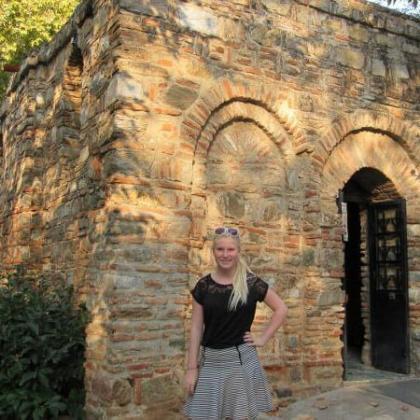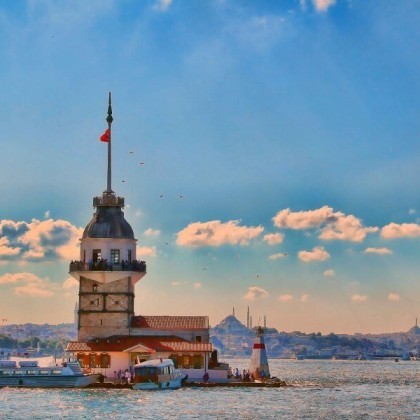Patara
Though this tiny, hard-to-reach village has a few cozy restaurants, its seemingly endless (13mi.) sandy beach is its main attraction. On the way to their daily beach worship, visitors marvel at the imposing ruins that lie peacefully among seaside hills. Remote sand dunes showcase the evening’s stars, while streetlights illuminate the mosquito-controlling bats’ next meal. The seat of the Roman governor of Lycia, Patara was an important port before its harbor silted up. It was also the birthplace of St. Nicholas, better known as Santa Claus.
Istanbul New Year’s Eve Party Cruise on the Bosphorus
IstanbulWith this new year's eve party program in Istanbul, you will have an amazing new year party on the Bosphorus. Book it now and don't miss the special price!
View Tour3 Days Ephesus, Pergamon and Pamukkale Tour Package
Ephesus, Pamukkale, PergamonIf you want to make an amazing trip to the Ephesus, Pergamon, and Pamukkale, you should read our tour itinerary.
View TourIstanbul and Cappadocia Tour – 7 Days
Istanbul, Cappadocia, TurkeyIf you want to make a trip to Istanbul and Cappadocia both, we strongly suggest you join this amazing package tour. This tour covers all the accommodations, transportations, lunches...
View TourBest of Turkey Package Tour – 8 Days
Istanbul, Cappadocia, Ephesus, PamukkaleAre you looking for a good traveling package in Turkey? With our 8-days Turkey tour, you will make a trip to every important sight in Turkey. Enquire now for...
View TourTRANSPORTATION AND PRACTICAL INFORMATION
Pamukkale offers bus service from Fethiye (1hr., every hr. 7am-7pm, $2). From the bus stop at the Antalya-Patara fork, take a dolmuş into town (2km, $.60). From town, another dolmuş runs to the nearby beach (10min., every 30min. 8am-6pm, $.50). From the dolmuş station (843 51 17 or 843 51 18), dolmuş nut to: Fethiye (1hr.; 9:15, 10, 11am, 5pm; $2); Kalkan (30min., every hr. 8:45am-6:30pm, $1); Kaş (1hr., every hr. 8:45am-6:30pm, $2); and Saklikent Gorge and Xanthos (10am, $5). Call Patara Taksl (843 50 50; from the beach 843 52 52) for taxis.
Kırca Travel (843 52 98; fax 843 50 34), run by the same family as the Flower Pension, offers transport to the airport ($40) and Letöon ($10) as well as treks into the mountains ($10-60). St. Nikolas Travel, across from St. Nikolas Pension, offers a variety of boat trips to all the classic Turkish Riviera destinations, including Kekova, Myra, Ölüdeniz, Butterfly Valley, Kalkan, and the islands. Tours depart from the office. (843 53 08; fax 843 50 24. $18-25 per person; barbecue, lunch, and wine included.) They also offer daily 15km canoe trips on Xanthos River (10am-5pm, $14.50 per person) and trips to Saklikent Gorge, Tıos, and Xanthos. (Daily 9:30am-6pm, $14.50)Han Horse Hiding, next to the PTT in the Vitamin Bar, offers horseback trips along the river and the beach. (843 51 55. 2-3hr. tours, depart 7am, 4pm; $32-45 per horse.)
Several places along the road into town and in town offer internet access for $2 per hour. The cheapest access is at Kirca Travel ($1.50 per hr.). A helpful nurse lakes the place of a health center. The PTT, near the dolmuş station in the town- center, has international phones and currency exchange. (843 52 20. Open daily 10am-10pm; closed Nov.-Apr.)
ACCOMMODATIONS
Elisions in the town center can be a bit loud, but. all are subject to the early morning call to prayer from the mosque. Affordable pensions are found on the road into and the road past the dolmuş stop.
- Zeybek-2 (843 50 86). Patara’s ruins and twilight beauty can be seen from the terrace of this pension with clean, beautiful rooms, all with bath, balcony, and fan. Breakfast included. Singles $7; doubles $10.
- Flower Pension (843 51 64; fax 843 50 34), 200m before the Centrum. Turn right off the. main road onto a small dirt road marked by 5 pansiyon signs. Call ahead for free pickup from the main road. 11 rooms with colorful woven rugs, bath, screens, balcony, and mosquito nets. Free laundry. Delightful eating area. Delicious homemade Turkish dinner $3.50. Breakfast included. Singles $7.50; doubles $10.
- Akay Pension (843 50 55; fax 843 51 72), on the right off the main road from Fethiye. A green and pink building next door to the Flower Pension. A wonderful gay room and 12 clean rooms with bath and mosquito nets and fan. Homemade Turkish dinners. Breakfast included. $5 per person.
- Paradise Pansiyon (843 51 90; fax 843 50 78), behind the Akay Pension. This simple pension offers 8 rooms with bath, mosquito netting, terrace, and a fan. Free laundry. Internet access $2. Dinner $3. Breakfast included. Singles $6; doubles $10. Medusa Camping (843 51 93), across from the dolmuş station. Look for the hand- painted green sign. Clean showers and toilets, but a small tent area. Bring your own tent or caravan. $1.50 per person. Electricity $1.
FOOD AND NIGHTLIFE
- Keravansaray (843 50 02), past the dolmuş stop, heading out of town. Filling set menus of chicken, meat, or fish with salad, fruit, pancakes and mezes for $4, Requisite Ottoman-style seating under ambiance evoking lights.
- Ayşe’s Pancake House (843 50 71), in the center of town. A family business specializing in gözleme of every variety, including banana-chocolate ($1.50-3.50). They also serve mantı (meat ravioli in yogurt sauce). Open daily 8am-midnight.
- Bistrot Restaurant (843 51 85 or 843 52 31), in the town center under the Otlu Market sign. This cozy eatery serves up southern Turkish cuisine under a lush grape arbor. Try the içli köfte (mixed meat, flour, and spices; $3.50), the Adena aşuresi (a custard like dessert; $1.80), and their special drink, boğma (“The Bomb”; $6). Billiard table $3.50 per hr. Internet access $3 per hr. Open daily 8am-4am.
- Gipsy Bar ( 843 50 09), across from the dolmuş station. For a late-night game of pool or a little dancing to current hot tunes. Beer $1; rakı $1.50. Open daily noon-4am.
- Voodoo Bar (843 52 73), on the right along the main street as you head to the dolmuş station. A small flower-engulfed refuge. Spend the evening talking over rum ($4) or beer ($1.50). Open daily 10am-3am; closed Oct.-Mar.
SIGHTS
Patara’s calm beach is a nesting ground Tor the shy loggerhead turtle by night (see Save the Sea Turtle), but by day it’s licked by a pleasant surf and is not exceptionally crowded. Strangely enough, there’s little swimming to be done due to high sandbars. The nearby Lycian archaeological site is somewhat hidden in the grass, and is largely unimpressive save the Mettlus Modestus Arch, built in 100 AD, which rests on the right of the road to the beach. A half-covered and well-preserved amphitheater lies farther in the field to the right, and is a fine site for an evening picnic after a day of bronzing. A necropolis with numerous sarcophagi surrounds the gate. The ruins of Roman baths, a Christian basilica, the Baths of Vespasian, and a theater lie along the path from the gateway to the sea. (Tickets $4, students $2. Tickets can be purchased on the road to the beach and are good for a week. Open daily 8am- 8pm. Wear good shoes to the beach or your soles will sizzle.)
DAYTRIPS FROM PATARA
LETOON
The best ways to get to Letoon are by taxi from Patara ($20) or by ally tour with companies from Ölüdeniz , Patara , Kalkan , or Kaş . Dolmuş from Kaş can drop visitors off about 2km from Letoon in Kinik ($2), where taxis will go the rest of the way ($150). Site open daily 8am-7:30pm. $1.50, students $.50.
An impressive archaeological site close to Patara, Letoon was a Lycian religious sanctuary whose ruins date from the Roman and early Byzantine periods. The Lycians founded this site in honor of Leto, who, after giving birth to Zeus’s illegitimate children, Artemis and Apollo, came here to escape the wrath of Hera, Zeus’s jealous wife. Leto and each of her children have a temple at the site. The central Leto temple bears only the marks of the thick Ionic columns that once stood there. Mosaics of Apollo’s lyre and Artemis’s bow and arrow decorate the floor of the Temple of Apollo. The church also bears mosaic floors and a Greek-inscribed tablet that was used to decipher the Lycian language. The large theater, opposite the temples, is marked by a remarkably well-preserved entrance pediment, and the outer part of the other entrance is adorned with a row of 16 detailed theater masks representing Dionysus, Silenus, a satyr, a girl, and a comic old woman.
XANTHOS
To get to Xanthos, take a Fethiye-bound dolmuş or bus from Patara (15min., $1), Kaikan (11hr., $1.50), or Kaş, which will actually pass right by the site. Otherv/ise, take a taxi ($10) or tour from Patara. Site open daily 8am-7:30pm. $2, students $1.
Most notable for their rock tombs, the rains of the ancient Lycian capital of Xanthos are perched above the Eşen River, 851cm from Fethiye and 22km from Kalkan. In the 6th century BC, the Lycians steeled themselves for a last stand against the Persians. When all hope was lost, they torched the city and fought to the death. The Romans later fortified Xanthos in exchange for military support.As you climb the road to Xanthos, check out the Roman city gate, dedicated to Emperor Vespasian. At the end of the well-preserved theater, to the left past the entrance gate, stands the 6th-century BC Lycian Tomb of the Harpies, a misnamed structure whose women are presumably Sirens conveying souls to the Isles of the Blessed. The remains of the acropolis and a Byzantine church are visible from the theater. Make your way past the neighborhood goats to see the 5th-century BC Xanthian Inscribed Pillar, the largest and oldest known Lycian inscription, standing across from the theater in the agora area. Its 250 lines in the Lycian language, describing Lycian battles in the Peloponnesian Wars, are followed by 12 lines of satire in Greek. Walk 200m through the parking lot to a Byzantine basilica, with several large, colored floor mosaics buried beneath a layer of sand. More remote but unique in its highlights is the necropolis on the other side of the basilica, with ancient rock tombs and engraved sarcophagi.
BOYS II MEN
There are two Muslim rites essential to a boy’s transition into manhood. The first, the circumcision ritual, is meant to emphasize cleanliness and is regarded as a boy’s first wedding patty; the second being his real marriage and the completion of his masculine development. The ceremony generally occurs during one of the summers during a boy’s primary school days (age 6-9} and is done with a pair of closely aged boys, such as brothers or cousins. The day commences with an expansive party and lunch, with the boys’ family and neighbors in attendance. After the meal, a caravan parade of decorated cars driven by the men of the party drives through the town streets honking horns, the young boys at the front of the train dressed in sashes reading (“all the best”) and topped off with scepters. The (circumcision rites) are then administered by a muslim hoja after which the circumcision occurs (with anesthetic). The ritual is over after the boys are bedecked in money and gold, given to them as they lay on a bed. The boys must wear special gowns that cannot touch the , equipment until after the stitches heal.





